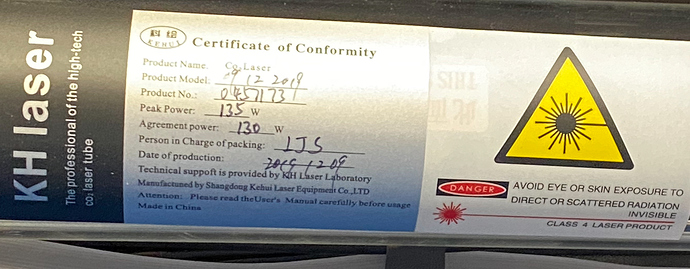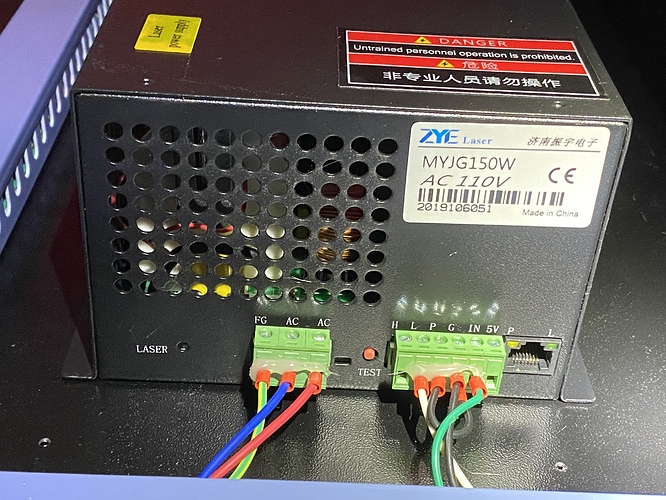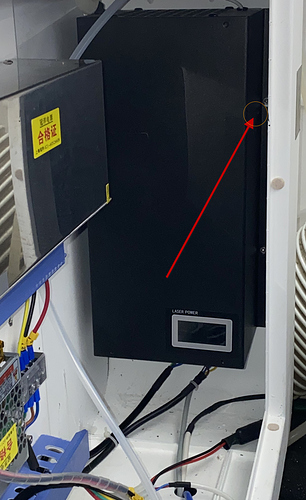Was preparing to engrave a Power Scale Test grid per LB instruction manual but I decided to do a few tests first and discovered that my mA were as follows for my 130w laser: (speed 20/mA10, 30/14, 40/19, 50/24, 60/29, 70/maxed). My mA meter maxes at 30 and power 70 pinned the needle I presume around 34. I stopped there since everyone says to keep mA mid twenties. I can’t find any definitive information regarding safe operating mA for 130w tube. My tube has no discerning marks on it to search for specs. Anyone know anything?
Well it would be hard to pick an exact number without knowing brand and model, but an EFR F6 tube is rated at 130W and it has a max current of 30mA and a recommended current of 28mA or less.
http://efrlaser.com/3-co2-laser-tube/200479/
And it seems that a lot of Ruida users find that their max tube current occurs at around 60 - 70% of “indicated” power. My 80 watt tube is maxed at 67%
Tx yes I’m mostly seeing recommendations of 26-28mA max for best life. In my case that means never going over 60%, which seems a waste.
You need to adjust you laser PSU. There’s no waste.
I finally tuned my laser PSU with the adjustment pot, and I had to get creative
Seems to me that 28mA at 60% vs 28mA at 100% (after trimming pot) is still the same actual laser power?
Maybe this helps, an analogy for you. Imagine your laser tube is a light bulb. The amount of amperage drawn by the bulb is that of the watts divided by the voltage. However volts, watts, or amperage doesn’t on its own indicate the effective light output.
There’s a few things to understand:
-
The manufacturer of your laser most likely installed your laser PSU without tuning it. You see, when you send 1 - 100% power from the software, that value is sent to the controller. The controller then sends the appropriate signal level to the Laser PSU.
-
That PSU was not made / matched for one specifically manufactured laser tube. That would be impossible. Even identical models of a laser tube are different. Therefore, the laser PSU is designed to output currents within ranges and the upper end of this range is managed by that trim pot. A laser PSU is a constant current power supply. The expected or effective output of the laser beam should be directly related to the current. (however we know other variables are at play here such as tube age, optics, etc).
-
The only way to truly measure the effective output of your laser tube relative to the current draw is:
Tx I’m convinced. Problem is- can’t find any adjustment pot anywhere. Unless I’m supposed to stick a screwdriver in the “Laser” hole?
Have another look at my post / that link I provided earlier. I have that same Power Supply model number (just a different version that has a digital ammeter built in to it). The pot is on the right side.

I finally tuned my laser PSU with the adjustment pot, and I had to get creative
Tx Jeff for sticking with me here- I did find a microscopic hole with a shiny brass screw inside- they don’t make it easy do they? So I presume I will now adjust that by quarter turns and test the laser, aiming to get 28 mA at 100% power? Is there a way to test power coming off the PS directly with a multimeter? What points would I test and what values would I being looking for?
From your earlier post, it sounded like you already have an ammeter on your laser. I just lowered my Z really low and out of focus and drew some long lines in LighrtBurn. I started the layer at 60% aiming it on some ceramic. I just trimmed it down to 20 mA at 60%. Then I increased the layer power percentage from there. Maybe 80% next, trimmed it back to 20 or so mA. Then 99% I tuned it to 28mA.
Don’t do that. The ignition voltage of your laser tube is roughly 28,000 volts. You should not ever be actively probing anything on a laser PSU.
And it isn’t uncommon that multi meters max out at 600v. Just read the ammeter already connected in line if you have one installed.
Yes I have an ammeter in-line and can do as you say. From the discussion you linked to, that Bonjour guy was implying there is a more accurate method with “a multimeter and a screwdriver”. He didn’t elaborate other than to say “google it” which I did and got nowhere. Anyways thanks for your help on this Jeff.
Thanks everyone for the pointers. I’ve got my 130w putting out 29mA at 100%.
Happy with that.
This topic was automatically closed 14 days after the last reply. New replies are no longer allowed.



